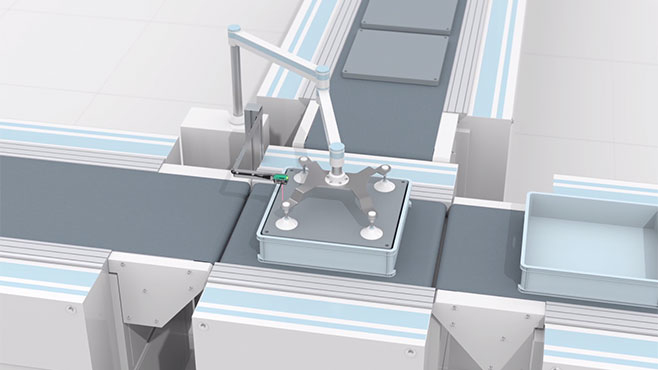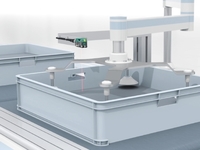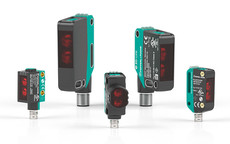Detecting Different Stacking Heights with Only One Sensor

Application
Conveyer lines connect separate manufacturing stations in complex, segmented production plants to optimize the flow of intermediate products. The amount of items inside each transport bin on the conveyor lines can vary. When a bin arrives at a production station, a suction gripper removes items one by one for the next steps in the manufacturing process.
Goal
Because the number of pieces inside each bin varies, the unloading process has to be flexible. To avoid process delays upstream and to optimize the entire production flow, the presence of intermediate products should be detected reliably and the next bin in line should be moved into place at the right time. For this reason, the next bin is sent to the production station before the last piece is removed from the bin that is currently being unloaded. Immediately after the bin leaves the unloading station, the next bin is then moved into place.
Solution

The R100 series photoelectric sensors ensure maximum efficiency in the manufacturing process.
Switching sensors with an R100-series measurement core are perfectly suited to detect two different stacking heights. By configuring two switch points, two work steps can be done with only one sensor. The sensor detects when the second-to-last item has been unloaded and sends a signal to the previous conveyer segment. Then, the next bin can be moved into place before the first bin has been completely unloaded. The second switch point detects when the bin is empty—after the last piece has been unloaded—and the bins are exchanged. This allows continuous operation of the suction gripper without standstill.
Benefits
With Multi Pixel Technology, it is now possible to use only one sensor where two were needed previously. Multi Pixel Technology features highly reliable and interference-free distance measurement in the micrometer range. This allows reliable detection of even extremely small height differences. Because of its compact size, the measurement core can be integrated even in the smallest sensor. Two switching outputs, independent switch points, a variety of operating modes, and IO-Link ensure maximum flexibility.
R100 Series at a Glance
- Optimizing processes, increasing efficiency—with versatile, adjustable sensors
- Two sensors in one—sensors with two switch points due to Multi Pixel Technology
- Reliable, precise, and noise-immune distance measurement
- Maximum flexibility with IO-Link
- Reduced costs in purchasing and logistics








 +886 2 27227708
+886 2 27227708